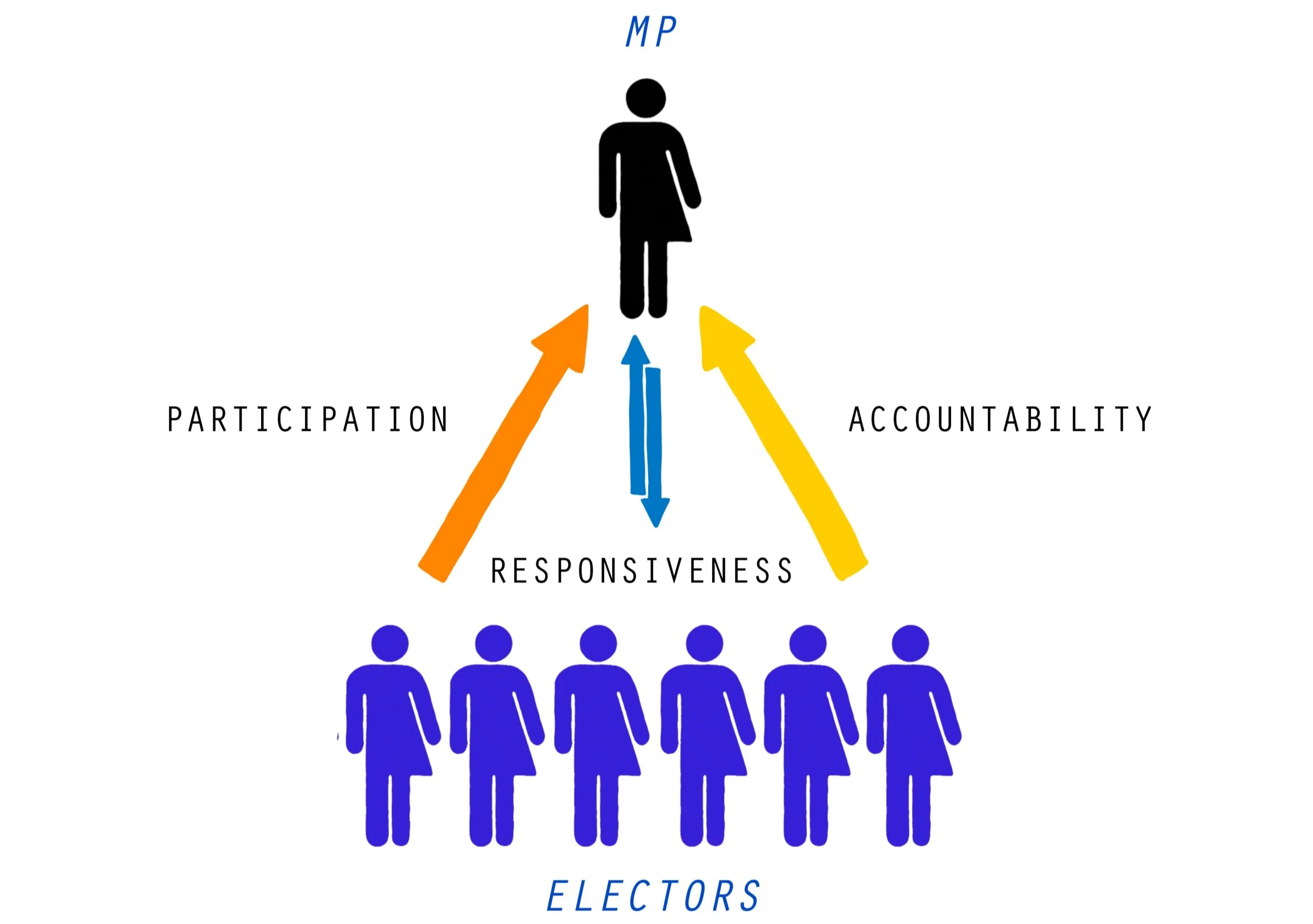What is representation?
Why is it important?
The study of representation is the study of power: who holds it, how they wield it, and why these functional aspects of democracy are important. Without understanding the exercise of power within political systems, including the relationships between different types of power, we are unable to evaluate the true intentions and effects of policy and decision-making and are liable to perpetuate cyclical and marginalising patterns of political behaviour.
Who are the constituents of a parliamentary member, who does this member claim to represent, and who influences their decision-making?
How are processes and decisions influenced by the identity, experience and relationships of parliamentary members?
Why do the composition (who) and processes (how) of parliament matter to its decision-making capacities?
Representation in Australia
Australia is a constitutional liberal democracy characterised by liberal citizenship values of equality of opportunity and a strong belief in individualism.
deliberative democracy
Australia’s 23 million inhabitants are represented by 151 members of the House of Representatives and 76 members of the Senate. Constituents grant members of parliament authority to make policy decisions on their behalf through elections held every three years .
rule of law
All Australians are considered to be equal under the law and are principally guaranteed due process.
extensive political freedoms
While Australia’s minimalist constitution has few enumerated rights, its citizens enjoy a level of freedom only shared by a handful of other countries.
federal division of powers
Responsibilities for policy-making and implementation are distributed between three levels of government: Federal, States and Territories, and Local Governments.
majoritarian responsible government
The Government is formed by the party that holds the majority of seats in the House of Representatives. The preferential voting, single-member electorate, model in the House of Reps supports a two-party system through which only the Australian Labor Party or the Liberal Party of Australia, in Coalition with the National Party of Australia, are able to form government. Other members of the House hold the government accountable for its decisions through parliamentary scrutiny and oversight.
The Australian Constitution provides for the formation of government through the Westminster Cabinet system, but does not mention the Prime Minister as its leader. By convention, the Prime Minister is the first among equals as the leader of the party in government.
Forms of Representation
The ways in which constituents are represented through the parliamentary body.
Formal
Equality of opportunity to access political institutions, structures, systems and processes.
ie. The passage of the Commonwealth Electoral Act 1962 created universal suffrage by extending the franchise to all First Nations Australians.
Symbolic
Role-modelling effects of political characteristics and behaviour, both positive and negative.
ie. The negative impact of sexist media treatment of Australia’s first female Prime Minister Julia Gillard on women’s political aspirations.
Descriptive
The degree to which population-level characteristics are proportionally reflected in parliamentary composition. True congruency between population and parliament is mirror representation.
ie. In September 2019 the Australian Senate reached parity gender representation for the first time.
Substantive
Critical acts and actors that make legislative changes directed toward a specific issue or group.
In a deliberative democracy like Australia, constituents grant authority to members of parliament to make policy decisions on their behalf. This consent is given through elections and operates as a combination of the following models of representation:
Principles of democratic representation
MPs may act as delegates to parliament, casting their votes on the basis of the majoritarian view in their electorate. This form of promissory representation focuses on the dyadic (principal-agent relationship) aspects of representation.
MPs may act as trustees on behalf of their electorate, anticipating constituents’ responses to their decision-making at the next election, relying on their personal values in decision-making (gyroscopic representation), or claiming to act as a surrogate on behalf of groups beyond their electorate. These forms of representation are indirect, systemic and deliberative in nature.
The most common form of representation in Australian Parliament is partisan representation. Australia’s majoritarian electoral system lends itself to the development of a two-party dominated parliament through which members of parliament are expected to conform primarily to the wishes of the party, even when they do not reflect the position of their electorate, experience or identity.
When MPs are acting as delegates or trustees they may have the latitude to pursue legislative change on the basis that it supports or ameliorates the disadvantages of their communities (electorate or identity-based). In contrast, partisan representation favours the party plurality and diminishes the chance that non-traditional political actors are able to influence change in a substantive manner.
ie. The 2017 amendment to the Commonwealth Marriage Act that created marriage equality for Australians of all sexual orientations:
ALP and LNP MPs that voted against their constituents’ no votes, in favour of the Bill, exercised trustee representation (these MPs had indicated support for the Bill regardless of party or electorate level disagreement). This is also true of LNP MPs that chose to abstain from voting on the legislation.
LNP MPs that voted with their constituents’ no votes, against the Bill, and all MPs that voted with their electorate’s preference in the marriage equality plebiscite enacted delegate representation.
ALP MPs, while still technically exercising a conscience vote, were bound by a partisan commitment to marriage equality in the party platform that included a binding yes vote if an amendment had not been made by 2019.
Claims-making in representation
The Policy Cycle
The Representative Cycle
The representative cycle is a diagrammatic visualisation of responsiveness in parliamentary representation:
A member of parliament’s understanding of self and their place in society influences the claims they make on their own behalf and on behalf of others;
These claims influence the policy decisions that are considered, evaluated and implemented;
Policy design and implementation in turn affects the way individuals and groups view the role of government in their lives and trust the decision-making of their representative;
Levels of trust in government influence the likelihood that citizens will become involved with the political process, including sharing concerns with their local member; and
A more engaged populace should have an expansionary effect on an MP’s worldview and influence the claims they present to parliament.
Representation is fundamentally an exercise in claims-making; in the expression and positioning of values and interests in parliamentary procedures and relationships. At each stage of the policy cycle political actors are making claims that determine who can - and should - be represented. Importantly, this process may be unconscious and guided by cognitive short-cuts and social networks.
Measuring descriptive representation through parliamentary composition is one way to uncover the potential influence of these practices on parliamentary processes: in committees, caucuses, private members’ statements, legislative debates and the budgetary process among others. Mainstreaming theory indicates that diversity must be considered holistically: conflicting identity claims must be presented at each stage of parliamentary processes as the practice of a fully integrated diversity-sensitive organisational culture; as illustrated in the following set of questions.
Each member of parliament will intuitively and critically have different responses to each of these questions, influenced by their personal experiences; education; partisanship; networks and relationships. More diversity in these responses increases the vibrancy of, and engagement with, the parliamentary informational ecosystem and improves representation of a broader range of the electorate’s opinions.
To ensure that parliamentary processes consider these questions - to force recognition of different perspectives in system design - the representative system relies on proportional-to-population diversity in the actors establishing and implementing these processes. Such a diversity sensitive parliament requires sufficient representation of non-traditional political actors within parliament to fulfil its democratic aims.






